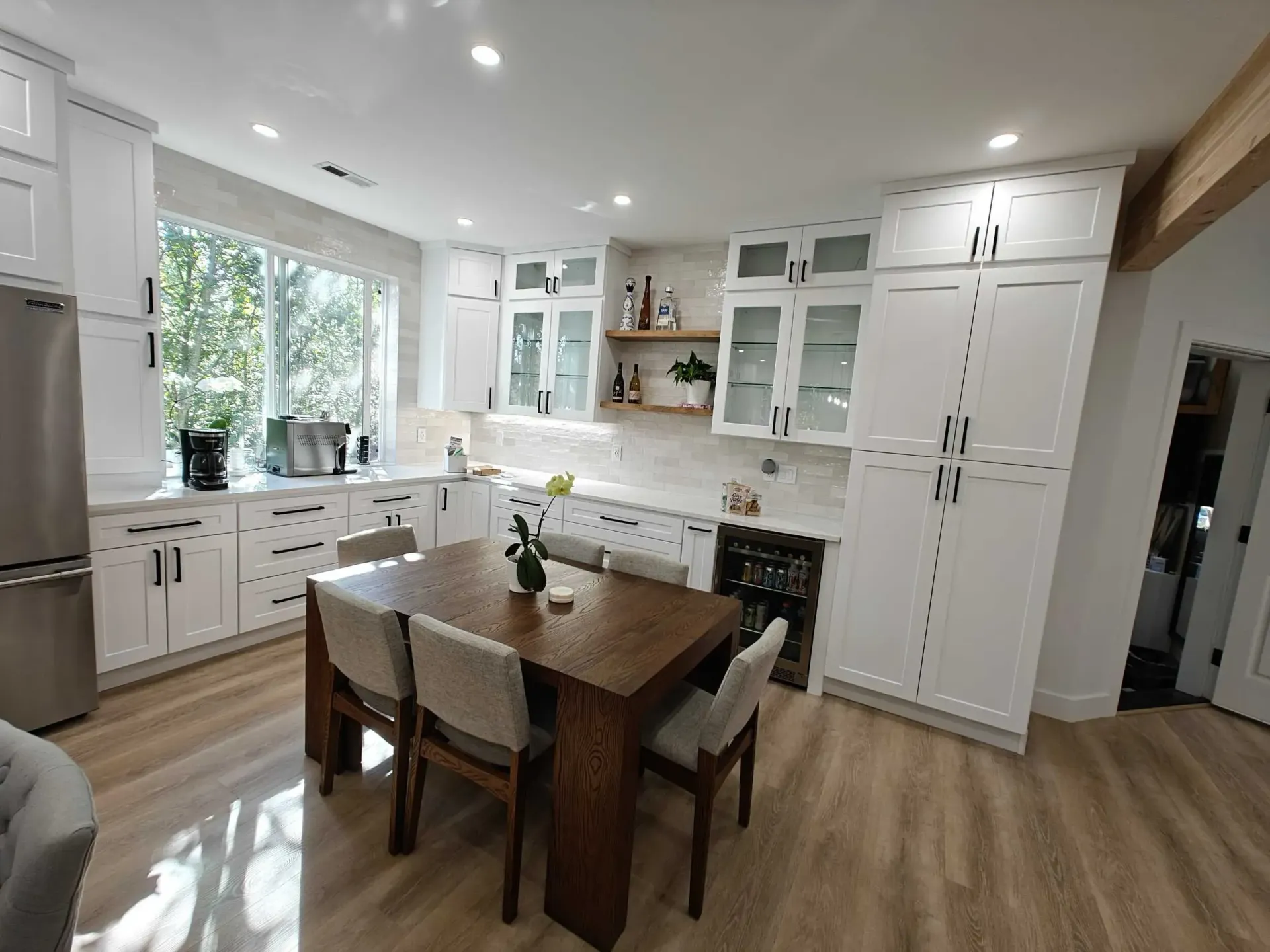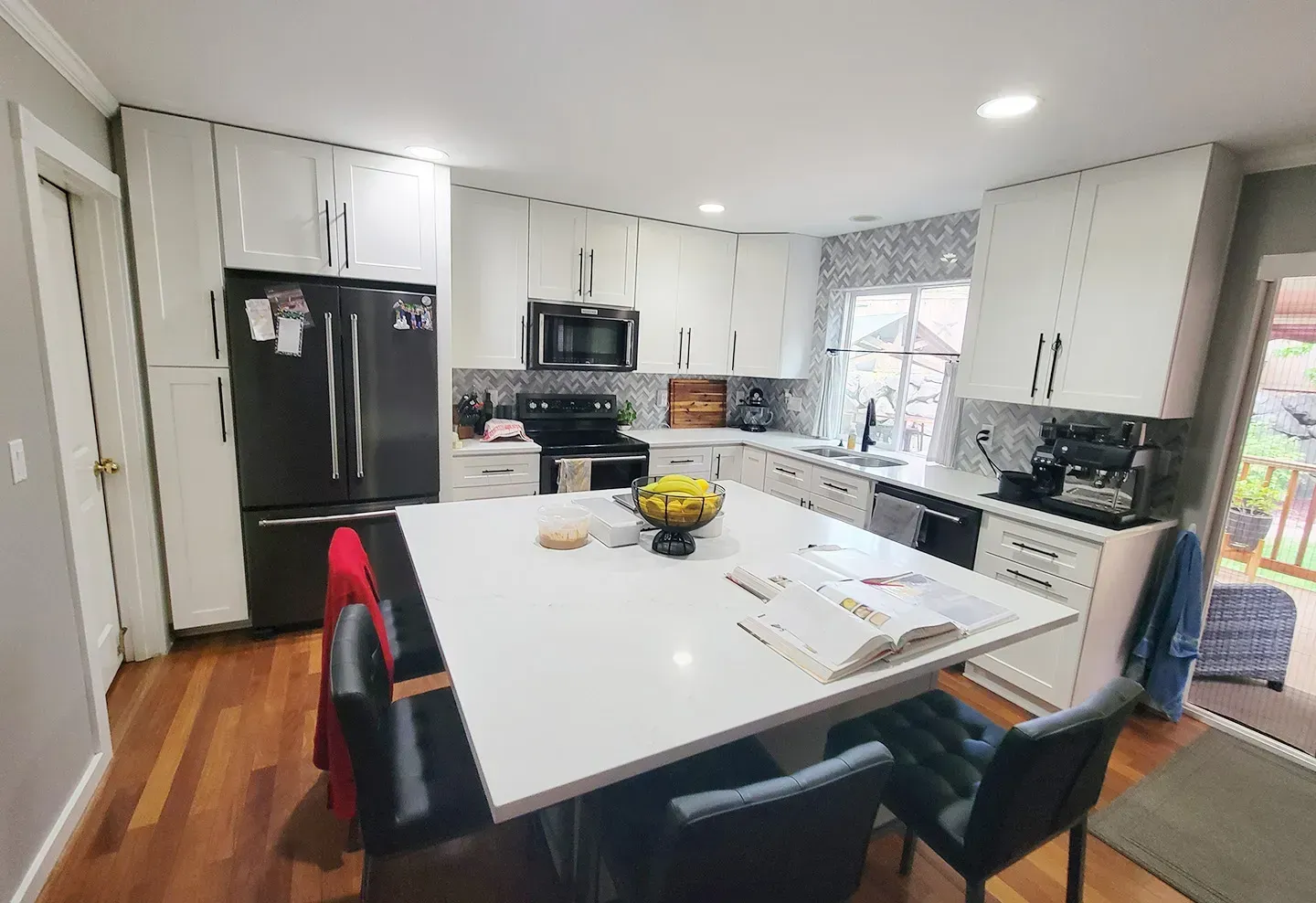
Cabinet Refacing vs. Replacement: Which Option is Best for Your Kitchen?
Kitchen cabinets are one of the most noticeable features in any kitchen. Over time, they can start to show signs of wear, making the space feel outdated. When it’s time for a refresh, many homeowners find themselves debating between refacing their cabinets or replacing them entirely.
Both options have their pros and cons, and the right choice depends on your budget, timeline, and design goals. In this blog, we’ll break down the differences between cabinet refacing and replacement. From costs to aesthetic outcomes, you’ll gain the insights you need to make the best decision for your kitchen remodel.
What Is Cabinet Refacing?
Cabinet refacing is a remodeling process that gives your kitchen a fresh new look without replacing the entire cabinet structure. Instead of removing your existing cabinets, refacing involves replacing the visible parts, such as doors, drawer fronts, and hardware, while keeping the cabinet boxes intact.
During the process, a veneer or laminate is applied to the cabinet frames to match the new doors and drawers. This approach works best when your cabinets are structurally sound but look outdated or worn. It’s also a great option if you’re happy with your current kitchen layout and don’t need to make structural changes.
Refacing is a quick and affordable way to modernize your kitchen while minimizing waste and disruption.
What Is Cabinet Replacement?
Cabinet replacement involves removing your existing cabinets entirely and installing new ones from scratch. This option allows you to completely redesign your kitchen, including changing the layout, upgrading storage options, or adding custom features.
With replacement, you have the freedom to choose from a wide range of materials, styles, and finishes. Whether you opt for stock cabinets, semi-custom options, or fully custom designs, this approach gives you total flexibility to create the kitchen of your dreams.
Cabinet replacement is ideal if your existing cabinets are damaged, outdated, or if you want to address deeper issues like improving functionality or upgrading to high-quality materials. While it’s more costly and time-consuming than refacing, replacement delivers a brand-new look and feel to your kitchen.
Cost Comparison
When deciding between cabinet refacing and replacement, cost is often one of the biggest factors to consider. Here’s a breakdown of what you can expect to spend on each option:
Cabinet Refacing Costs
Refacing is generally the more budget-friendly option. On average, it costs 30–50% less than a full cabinet replacement. For most kitchens, refacing typically ranges from $4,000 to $10,000, depending on the size of your kitchen and the materials you choose.
Cabinet Replacement Costs
Replacing cabinets is a larger investment, with costs typically ranging from $8,000 to $20,000 or more. The price depends on factors like the type of cabinets (stock, semi-custom, or custom), materials, and additional work required, such as adjusting plumbing or electrical systems.
Which Is More Cost-Effective?
- Refacing is a smart choice if your cabinet frames are in good condition and you want to save money while achieving a refreshed look.
- Replacement is worth the higher cost if your cabinets are damaged, poorly designed, or if you want to significantly upgrade your kitchen’s functionality and style.
Understanding the cost difference helps you determine which option aligns with your budget and goals.
Timeline for Each Option
The timeline for your project is another important consideration when choosing between cabinet refacing and replacement. Here's how the two options compare in terms of time:
Cabinet Refacing Timeline
Refacing is a relatively quick process, often taking just 3–5 days to complete. Because the cabinet frames remain in place, there’s no need for extensive demolition or reconstruction. This makes refacing an excellent option if you want to minimize downtime and disruption in your kitchen.
Cabinet Replacement Timeline
Replacing cabinets is a more time-intensive process, typically taking 1–3 weeks or longer, depending on the complexity of the project. Factors that can extend the timeline include:
- Removing and disposing of old cabinets.
- Adjusting plumbing, electrical, or ventilation systems.
- Waiting for custom cabinets to be manufactured and delivered.
Which Option Saves Time?
If speed is a priority, refacing is the clear winner. However, if your kitchen requires major changes or custom solutions, the longer timeline of replacement may be necessary to achieve the desired results.
Aesthetic Outcomes
The final look of your kitchen is a key factor in deciding between cabinet refacing and replacement. While both options can dramatically improve your kitchen’s appearance, they offer different levels of flexibility and transformation.
Cabinet Refacing Aesthetics
Refacing gives your cabinets a fresh, updated look by replacing doors, drawer fronts, and hardware. With a wide variety of veneers, laminates, and finishes to choose from, you can achieve almost any style—from modern and sleek to traditional and warm.
However, the structure of your cabinets remains the same, so refacing is limited to working with your current layout and frame design.
Cabinet Replacement Aesthetics
Replacement provides complete design freedom. You can choose new styles, materials, and configurations, including custom options that perfectly match your vision. Whether you’re looking for open shelving, decorative moldings, or entirely new storage solutions, replacement offers endless possibilities.
Which Option Enhances Your Kitchen More?
- Choose Refacing if you want a cost-effective aesthetic upgrade without altering your kitchen layout.
- Choose Replacement if you’re looking for a full design overhaul or want to incorporate custom cabinetry into your kitchen remodel.
Both options can deliver stunning results, but replacement offers greater flexibility for homeowners seeking a dramatic transformation.
Durability and Longevity
When investing in your kitchen, it’s essential to consider how long the results will last. Both cabinet refacing and replacement can offer durable solutions, but their longevity depends on the materials used and the condition of your existing cabinets.
Cabinet Refacing Durability
Refaced cabinets can last 10–15 years or more if high-quality materials are used and the underlying structure is solid. However, the lifespan is limited by the condition of the original cabinet boxes. If the frames start to weaken over time, you may eventually need a full replacement.
Cabinet Replacement Durability
New cabinets, particularly those made from high-quality materials like hardwood or plywood, can last 20–30 years or longer. Replacement also allows you to address structural issues and choose durable finishes that stand up to daily wear and tear.
Which Option Offers More Longevity?
- Refacing is a great choice if your cabinets are in good shape and you’re looking for an upgrade that lasts over a decade.
- Replacement is better if you want a long-term solution or if your cabinets are already showing signs of significant wear.
By assessing the current condition of your cabinets and your long-term needs, you can determine which option provides the durability you’re looking for.
Environmental Impact
The environmental footprint of your kitchen remodel is another factor to consider. Cabinet refacing and replacement have different impacts when it comes to sustainability and waste.
Cabinet Refacing and Sustainability
Refacing is inherently more eco-friendly because it reuses your existing cabinet frames. By avoiding the need to tear out and discard old cabinets, you significantly reduce waste. Additionally, many refacing materials, such as veneers and laminates, are made with sustainable practices in mind.
Cabinet Replacement and Waste
Replacing cabinets generates more waste, as the old cabinets are typically discarded. However, there are ways to make replacement more sustainable, such as donating old cabinets to organizations like Habitat for Humanity or choosing new cabinets made from eco-friendly materials, like bamboo or recycled wood.
Which Option Is Better for the Environment?
- Refacing is the greener option, as it reduces waste and extends the life of your existing cabinets.
- Replacement can also be environmentally conscious if you opt for sustainable materials and proper disposal of old cabinetry.
If minimizing your environmental impact is a priority, refacing is the clear choice, but thoughtful planning can make replacement a responsible option as well.
When to Choose Refacing
Cabinet refacing is an excellent option for homeowners who want a cost-effective and efficient way to update their kitchen. Here are the scenarios where refacing is the better choice:
1. Your Cabinets Are Structurally Sound
If your cabinet frames are in good condition—free of damage, warping, or significant wear—refacing is a practical option that lets you avoid the expense of a full replacement.
2. You’re Happy with Your Current Layout
Refacing works best if you don’t need to change the size or arrangement of your cabinets. It’s a quick way to refresh your kitchen’s appearance without altering its functionality.
3. You’re on a Tight Budget
Refacing costs significantly less than replacement, making it ideal for homeowners looking to achieve a stylish upgrade without overspending.
4. You Want a Faster Remodel
With refacing typically taking just a few days, it’s perfect for those who want a quick turnaround with minimal disruption to their daily routine.
Refacing is a smart choice for homeowners looking to modernize their kitchen quickly and affordably while maintaining the existing layout.
When to Choose Replacement
Cabinet replacement is the better option for homeowners who want a complete transformation or have issues with their existing cabinets. Here are the scenarios where replacement makes the most sense:
1. Your Cabinets Are Damaged or Worn
If your current cabinets are warped, water-damaged, or structurally unsound, replacement is the only way to ensure a durable and long-lasting solution.
2. You Want a New Layout
Replacing cabinets allows you to redesign your kitchen layout, adding more storage or improving functionality. This is ideal for homeowners who want to create a more efficient and modern kitchen.
3. You’re Ready to Invest Long-Term
Replacement cabinets, especially custom or high-quality options, provide superior durability and can last decades. If you’re planning to stay in your home for the long haul, replacement offers a better return on investment.
4. You Need Customization
Replacement gives you complete freedom to choose cabinets that fit your exact needs, whether it’s unique storage solutions, special finishes, or a specific style that isn’t achievable with refacing.
For homeowners seeking a fresh start or a high-end, personalized kitchen, cabinet replacement is the way to go.
Conclusion
Choosing between cabinet refacing and replacement depends on your budget, goals, and the current state of your kitchen. Refacing is a cost-effective, fast, and environmentally friendly option for updating cabinets that are still in good condition. On the other hand, replacement allows for complete design flexibility, improved functionality, and a long-term investment in your home.
By understanding the costs, timelines, and aesthetic outcomes of each option, you can make a decision that aligns with your vision and needs.
If you’re ready to transform your kitchen, Tubro Construction is here to help. We specialize in cabinet refacing, replacement, and full kitchen remodels. Serving Maple Valley, Tacoma, Covington, Renton, Kent, and Auburn, we’ll guide you every step of the way. Contact us today to get started on your dream kitchen!











